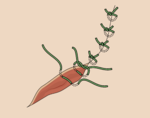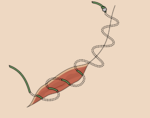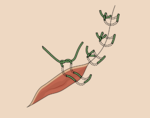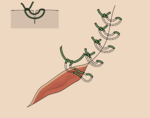Suture Materials
Suture Patterns
Suture patterns are commonly classified as follows:
- Appositional; these sutures hold the tissue in place in the normal anatomical alignment, such as with skin sutures.
- Inversion; these turn the edges of the wound inwards, for example when repairing intestinal anastamoses.
- Everting; these turn the edges of the wound outwards, and are useful to counteract sites where inversion of a wound may spontaneously occur, such as deep lacerations. In this situation an occasional everting sutures within a line of appositional sutures is useful.
Suture patterns are also commonly described according to the style of insertion. A few of the more common patterns are described below:
Simple Interrupted
This pattern apposes the wound edges with single sutures, knotted with square knots - 4 throws per knot are used for this style of suture. The advantages of this style of suture are that tension can be adjusted for each suture, and if one suture fails, the damage is less likely to be catastrophic. The disadvantages are the time taken to insert individual sutures and the amount of suture material required.
Simple Continuous
This pattern is also an appositional pattern, where the suture material is knotted only at the beginning and end of the suture. The advantage of this technique is the reduced amount of suture material in contact with the wound, and an even tension is achieved along the wound. The main disadvantage of this pattern is the risk of complete wound breakdown if any part of the suture line becomes damaged during healing. Use 5 throws at the start of the suture and 6 throws to finish.
Intradermal Insertion
Basic suture patterns can also be inserted intra dermally in order to reduce the amount of material on the external surface which is then vulnerable to interference by the patient. Intradermal sutures are well tolerated and have a pleasing cosmetic appearance, but are more time consuming to insert and require a little practise to do well. They can be a good solution to circumstances where post operative care will be impossible such as neutering of strays due for immediate release.
Horizontal mattress
Mattress style sutures have an everting pattern and are usually applied as single interrupted sutures with the knot placed away from the wound edge. Horizontal mattress sutures are placed so that the external suture material is aligned in parallel to the wound edge.
Vertical Mattress
Vertical mattress sutures are placed so that the external suture material is aligned at 90° to the wound edge.
There are many other styles of suture pattern used for specific surgeries such as orthopaedics.
Suture Placement Practicalities
If you are right handed, close the wound from top to bottom or from right to left. If you are left handed, close the wound from top to bottom or from left to right. Drive the needle through the tissue by facing it away from your body and towards the wound, keeping the needle holder between your body and the wound at all times. To appose the tissue edges take separate bites from each side of the wound. Only ever handle the ends of suture material with surgical instruments as you will reduce the tensile strength in areas that have been handled by instruments.
Do not tie your sutures too tightly, as post op swelling can cause the sutures to ligate the tissue if they are not loose enough when inserted. Slide the knot away from the wound once you have tied it to reduce irritation to tissues post operatively. If, when you are placing sutures you discover that there is significant tension on the wound edges, a second deeper layer of closure is needed.
Suture Materials
There are several different ways of categorising suture material, which can seem confusing. They can be categorised into absorbable/non absorbable or braided/monofilaments
Absorbable sutures
Absorbable materials (E.G. catgut) are designed to be fully absorbed, and they begin to loose their tensile strength from the first day that they are used in surgery. The material is absorbed through phagocytosis or hydrolysis. Clearly it is important that the strength reduces at the same rate that the wound gains strength. Absorbable sutures commonly used for tissue closure prior to the closure of the skin layer. Some absorbable suture materials have antibacterial properties to aid with asepsis.
Absorbable materials include:
- Catgut; made from sheep intestinal submucosa or cattle intestinal serosa, catgut is highly antigenic and can cause a profound tissue reaction which make the rate of absorption unpredictable. Catgut is available coated with chromic salts which lessens this effect.
- Polyglactin 910 (‘Vicryl’) is commonly used in as a synthetic alternative to catgut, as it is far less antigenic. It looses 45% of its tensile strength by day 14 post operatively, and 90% at 28 days. Polyglactin 910 is coated to reduce tissue drag and to improve the material's knotting characteristics.
- ‘Vicryl Rapide’ is a modified polyglactin 910 that has 70% less tensile strength than ‘Vicryl’ and is used mostly when an absorbable suture is required for skin closure.
- Polyglcolic Acid (‘Dexon’) is a coated synthetic absorbable material which looses its strength by 33% in 7 days It has high tissue drag despite being a coated material and poor knot security
- Polydioxanone (‘PDS’) has a slow rate of hydrolysis, which makes it ideal for extended tissue support. It looses 25% of its tensile strength after 14 days. The material has low tissue drag, which minimises tissue trauma, and is often used to suture tendons and fascia. Polyglyconate (‘Maxon’) is a similar material to ‘PDS’.
- Poliglecaprone 25 (‘Monocryl’) has a high tensile strength initially when compared to other absorbable materials, but it looses this strength rapidly; 40% in 7 days. It is commonly used for intradermal and subcutaneous wound closures.
Non absorbable sutures
- Silk (e.g. ‘Mersilk’) is a natural fibre that does degrade and is absorbed, but this occurs so slowly that the material is classified as non absorbable. It does induce considerable tissue reaction, and has significant capillary action, so can never be used in the presence contamination or established infection. It is mainly used for ligatures, and is available in a coated form to reduce the capillary action of the fibre. Knot security can be a problem with this material.
- Nylon (‘Ethilon’) is used predominantly for skin sutures as it has a high tensile strength, but the material's ‘memory’ – where the suture reverts back to the packaging shape – makes it hard to handle and knot security is poor.
- Polypropylene (‘Prolene’) is similar to nylon, but the material flattens when knotted which improves knot security. It induces little reaction once placed and is used for vascular surgery or when placing meshes in large uncontaminated wounds.
- Stainless steel is mainly used in haemostatic clips or skin staples to facilitate rapid wound closure. It is strong but fatigues easily. Stainless steel is available as a flexible suture material but it is difficult to use - it is indicated when a protracted time for tissue healing is required such as cases of significant wound breakdown in vital structures such as the linea alba.
- Tissue adhesives (‘Vetbond’, ‘Vetseal’) are indicated for the repair of small partial thickness wounds and some 'small furry' surgeries. The glue should be applied to a dry wound with adequate haemostasis as it polymerises quickly on contact with moisture. Adhesives are contra-indicated in the eye area because of the risk of accidental application into the eye.
Monofilament sutures
Suture material can also be classified as monofilament of braided: a monofilament material is a single strand of material which gives it the advantage of less tissue drag and no internal spaces to harbour bacterial growth when compared to braided filaments. Monofilament materials, however weaken if they are roughly handled during placement and have reduced ease of handling and knot security when compared to braided filaments.
Braided sutures
Multifilament or braided suture materials are comprised of several strands of material twisted together and coated to give them greater handling characteristics with good knot security and reduced tissue drag. They are contra-indicated in contaminated or infected tissues as bacteria can easily become established within the braided material where they remain undetected by the immune system.
A summary of the various materials available and the categories of suture material is as follows:
| Monofilment | Braided (Multifilament) | |
|---|---|---|
| Absorbable | Catgut
Polydioxanone (‘PDS’) Polyglyconate (‘Maxon’) Poliglecaprone 25 (‘Monocryl’) |
Polyglycolic Acid (‘Dexon’)
Polyglactin 910 (‘Vicryl’) |
| Non-absorbable | Nylon (’Ethilon’)
Polypropylene (‘Prolene’) Stainless Steel (suture material) |
Silk
Stainless Steel (staples) |
Suture Material sizes
Suture materials come in a variety of sizes and strengths. Use the smallest diameter that will adequately hold the tissue to minimise tissue trauma and reduce knot size whilst matching the strength of the suture material to the tissue.
There are several systems of sizing suture material; the metric system which indicates the diameter of the material, and the USP (United States Pharmacopeia) system which is more commonly used. With synthetic materials and catgut the USP system sizes these two classes of material differently; for example, 3-0 ‘Vicryl’ is the equivalent to 4-0 catgut in terms of the actual diameter of the suture material.



